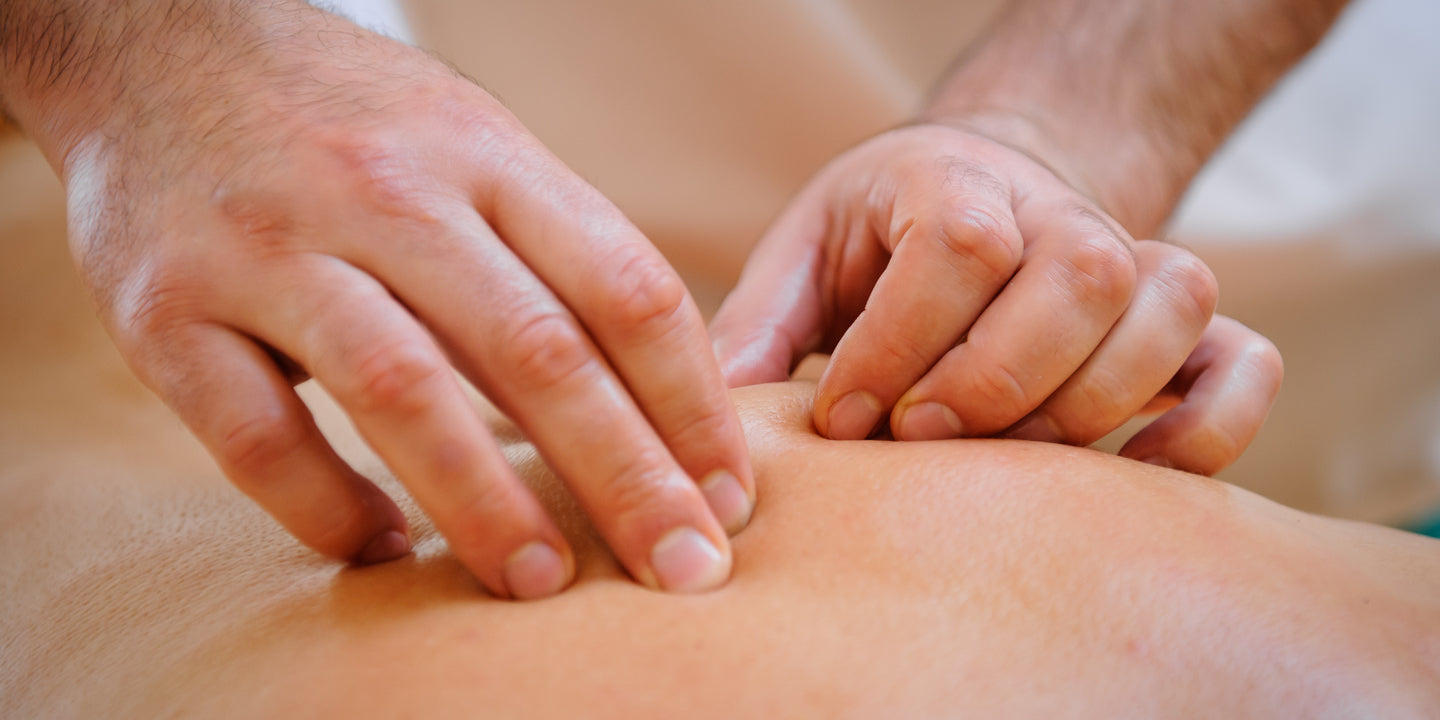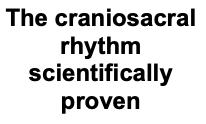The Craniosacral Rhythm (Primary Respiratory Mechanism - PRM) Scientifically Explained
Some osteopaths palpate the craniosacral rhythm (especially at the level of the skull of their patients), evaluate it for strength, symmetry, and timing. That rhythm is described as an expansion and contraction of the skull. They also treat the palpated dysfunctions of the craniosacral rhythm via tiny pulses and so-called "stilpoints" with the goal of making the patient healthier.
The goal is noble, but the underlying science is completely absent. There is ample scientific evidence that the craniosacral rhythm is non-existent.
Yet many osteopaths do feel this rhythm, all in a different way.
Consciousness
To clearly understand the palpation of the craniosacral rhythm, we must first clarify what consciousness is.
Consciousness is everything you experience. Osteopaths do palpate and feel the craniosacral rhythm consciously.
Our brain correlates with our body and with our environment (through the senses) through which our consciousness is shaped but also modeled (Seth et al 2015).
The properties of consciousness can be described in different ways.
Consciousness can be high and low as e.g. in sleep, under the influence of medication or drugs or in coma. Thus, our consciousness is not alert all the time. Nevertheless, we can even experience a certain level of consciousness during sleep, namely when we dream.
Not everything around us is part of our consciousness. We are selective in our experiences and intake of impulses.
Consciousness is also very personal. We are aware of ourselves and our place and role in our environment. We are aware of what we see, hear, smell, feel; each in our own way.
How and where does consciousness work in our brains?
Does it involve regions with very many neurons? No because e.g. the cerebellum has 4x as many neurons as other parts of the brain but if we switch off neurons here (stroke or surgery) there can be coordination problems, but our consciousness remains intact.
Does it involve a particular region of the brain? Neither because when switching off many separate regions, consciousness remains intact. However, consciousness does change when multiple parts of the brain are switched off.
Does it involve brain parts where there is more neuronal activity? Again, no.
Are there some special consciousness neurons? No.
What it does involve is the flow of information in brain activity between different parts of the brain. This can be demonstrated through electroencephalography and Transcranial Magnetic Stimulation (TMS).
All experiences, smell, sight, hearing, tactile ... create information flows in the brain that become integrated into consciousness. These integrated flows (neurocognitive processes) of information generate more information than the sum of its captured parts (Barrett & Seth 2011).
This can manifest itself e.g. in visual effects or illusions where one sees things that are not there ("fading" or "apparent motions").
Much also depends on our expectations of how the world around us looks or reacts. Our consciousness then often starts guessing at the best option ("best guesses").
Perception (checking what is really going on (what we hear, see, feel)) is a process of influences. The brain combines expectations with ambiguous incoming information. Consciousness then goes into "best guess" mode.
We can represent this in the diagram below.

For example, what we see (perception) is not only what enters through our eyes but is also influenced by past experiences and learning.
So, what we palpate (perception) is also not only what comes in through our tactile receptors but is also influenced by past experiences, what we are taught or by "best guesses."
What arrives through the various sensors in the brain is also already filtered; not everything is transmitted because previous experiences or expectations inhibit or even block it.
It is important to note that these perceptions or "best guesses" are also sending efferences to the neurological sensors (van Helmholtz H. 1821-1894, Seth 2013, Pascual-Leone 2001). As a result, we do feel what our brains offer.
We see what we expect; we hear what we expect; we feel what we expect.
This process of expectation is the greatest scientific explanation of consciousness (Seth 2016, https://aeon.co/essays/the-hard-problem-of-consciousness-is-a-distraction-from-the-real-one ).
There is a constant interaction (oscillation, orchestrated by the alpha rhythms (10Hz)) between the expectation process and the sensory incoming data.
Some visual examples:
The gray bar in the center is the same gray throughout, yet we see different shades of gray.
In this drawing, we can see different images.
An auditory example is the McGurk effect:
https://www.youtube.com/watch?v=2k8fHR9jKVM&t=39s
Some examples of tactile illusions:
https://www.youtube.com/watch?v=Q1z8QYCL5gk
https://www.youtube.com/watch?v=WdhnEq76_PA
https://www.youtube.com/watch?v=DphlhmtGRqI
In the practice of palpating the craniosacral rhythm, this means input from:
- Our fingertips encompassing the skull. This input is already not objective.
- Expectations created by teachers, authors, colleagues, pseudoscientific articles, and explanations. These expectations transcend tactile palpation which is then felt via afference anyway.
There is many evidence that the craniosacral rhythm does not exist: some examples:
- Hanten W.P., Dawson D.D., Iwata M., Seiden M., Whitten F.G. & Zink T. (1998) Craniosacral rhythm: reliability and relationships with cardiac and respiratory rates. J. Orthop. Sports Phys. Ther. 1998 Mar.;27(3):213-218. doi: 10.2519/jospt.1998.27.3.213. PMID: 9513867.
- Wirth-Pattullo V. & Hayes K.W. (1994) Interrater reliability of craniosacral rate measurements and their relationship with subjects' and examiners' heart and respiratory rate measurements. Phys Ther. 1994 Oct.;74(10):908-916; discussion 917-920. doi: 10.1093/ptj/74.10.908. PMID: 8090842.
- Sommerfeld P., Kaider A. & Klein P. Inter- and intraexaminer reliability in palpation of the "primary respiratory mechanism" within the "cranial concept". Man. Ther. 2004 Feb.; 9(1):22-29. doi: 10.1016/s1356-689x(03)00099-7. PMID: 14723858.
- Moran R.W. & Gibbons P. (2001) Intraexaminer and interexaminer reliability for palpation of the cranial rhythmic impulse at the head and sacrum. J. Manipulative Physiol. Ther. 2001 Mar.-Apr.; 24(3):183-190. PMID: 11313614.
- There are still many scientific articles that come to the same conclusion.
So why do some osteopaths and especially craniosacral therapists hold so tightly to their craniosacral rhythm concept?
Here we must briefly discuss the principle of cognitive dissonance (Festinger L. 1957): it is psychologically very difficult to change one's idea if it turns out that the already strongly held idea is wrong.
Dealing with criticism of one's own actions is painful; one automatically shoots to the defense.
There is the Dunning-Kruger effect (Kruger, Dunning, 1999): this is a psychological phenomenon by which people who overestimate themselves in a task or skill rate their performance higher than it really is. They lack the metacognitive ability to recognize that their choices and conclusions are sometimes wrong. In fact, it is then that when shown scientifically to be wrong, this even reinforces their misjudgment.
There is also the placebo effect that can play into the therapists' experience. They then think that any results of their treatment come from their manual craniosacral intervention.
There are also self-styled "osteopaths" who never learned scientific thinking and therefore do not apply it.
The explanation that the PRM exists is sometimes explained through the movement of the cerebrospinal fluid (CSF). However, although the CSF exists and flows, this does not explain the rhythm.
Conclusion
Even though some osteopaths do feel and treat a craniosacral rhythm, we must state that this is an illusion that is not useful as a diagnostic or therapeutic tool. These osteopaths are fooled by their own brain.
It is unfortunate that this craniosacral rhythm is still taught; it does not do the credibility of osteopathy any good.
A similar explanation can be given to the so-called "listening" tests and techniques that wrongly palpate subtle movements of organs and other body structures.
Bibliography
- Barrett A.B. & Seth A.K. (2011) Practical Measures of Integrated Information for Time-Series Data. PLoS Comput. Biol. 7(1): e1001052. https://doi.org/10.1371/journal.pcbi.1001052
- Festinger L. (1957) A theory of cognitive dissonance. Evanston, IL: Row, Peterson
- Kruger J. & Dunning D. (1999) Unskilled and Unaware of It: How Difficulties in Recognizing One's Own Incompetence Led to Inflated Self-Assessments. Journal of Personality and Social Psychology 77 (6): 1121–34. PMID 10626367. DOI: 10.1037/0022-3514.77.6.1121.
- Pascual-Leone A. & Walsh V. (2001) Fast backprojections from the motion to the primary visual area necessary for visual awareness. Science. 2001 Apr. 20;292(5516):510-2. doi: 10.1126/science.1057099. PMID: 11313497.
- Seth A.K., He B.J. & Hohwy J. (2015) Editorial. Neurosci. Conscious. Mar. 3; 2015(1): niv. 001. doi: 10.1093/nc/niv001. PMID: 29877513; PMCID: PMC5934887.
- Seth A.K. (2013) Interoceptive inference, emotion, and the embodied self. https://doi.org/10.1016/j.tics.2013.09.007
Author: Luc Peeters, MSc.Ost.


